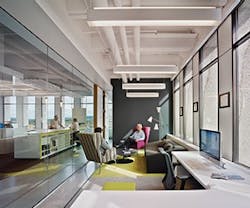Practical Solutions for Long-Term Lighting Problems
Facing a lighting challenge? You’re not alone.
Learn how these companies tackled three common lighting issues – they may spark an idea for your own retrofit.
1) Time and Labor Costs
The problem: The Westlake Village, CA headquarters of Dole Foods features a lobby with a 35-foot ceiling, which caused maintenance nightmares when lamp replacement was needed. Other spaces utilized inefficient incandescent lighting, and some – namely laboratories and test kitchens – were occupied 24/7, so lamp failures made it difficult to work.
The solution: Dole first installed LEDs in the lobby because their long lifetime cut down on the frequency of lamp changes, which required scissor lifts or scaffolding and special scheduling, according to Richard Myers, vice president of PIXI Lighting, which provided the flat LED ceiling light replacements.
After the results met their expectations, they began a phased installation in the spaces operating around the clock, as well as conference rooms, executive offices, hallways, and an underground parking garage.
2) Breakage and Abuse
The problem: Light fixtures at two Trillium Family Services campuses in Portland and Corvallis, OR, were constantly breaking. The behavioral health provider, which offers inpatient psychiatric treatment for youth ages 5-17 at both places, required constant lighting replacements when clients intentionally damaged the incandescent and old-style fluorescent lighting to hurt themselves or others.
“Our end goal is safety,” explains Mark Elledge, director of facilities for Trillium. “We want to protect our clients and our staff, and when things are breakable, it creates a major safety hazard.”
The solution: During major renovations at both sites, the Trillium team searched for fixtures that were both highly durable and aesthetically pleasing.
“You always want to create a homey atmosphere to try to make the kids feel comfortable, yet provide safety measures too,” Elledge explains.
The fluorescent fixtures that were ultimately installed feature tamper-proof screws and housing that held up while a Trillium FM tested them with a baseball bat.
“It’s always good to have a higher standard when it comes to safety,” Elledge advises. “It really comes down to durability and the length of time the fixtures will be installed.”
Trillium also achieved notable labor savings by eliminating the broken fixture problem. “The primary driver on this project wasn’t ROI, but one staffer had been on-call to fix the old lights on an emergency basis prior to the installation of the new light fixtures,” explains Mark Bolton, West Coast regional sales manager for Kenall Lighting, which provided Trillium’s new fixtures. “Now this on-call retainer is no longer a necessity.”PageBreak
3) Ambitious Sustainability Goals
The problem: Glumac, a full-service consulting engineering firm, bills itself as the “Engineers for a Sustainable Future,” but it was stuck in a highly inefficient space. When the company was preparing to move to its new Portland office on the 16th floor of the Standard Insurance Center, it needed a sustainable building retrofit and open-office layout to reflect its principles. Its new space brings in a high amount of sunlight, but the access to natural light required lighting controls that could balance natural and artificial lighting.
The solution: The team quickly realized that wired controls would be cost-prohibitive, so they opted for wireless lighting controls that integrated with the building management system and allowed Glumac to track lighting usage and make adjustments as needed. The new space was fitted with daylight sensors to automatically adjust the electric lighting and vacancy sensors in both open and private offices.
The result? Glumac’s space initially used just 0.32W per square foot, less than half the designed load of 0.68W and roughly a third of the maximum allowed by Oregon’s energy code. After a couple of months of fine-tuning, the organization reduced their load to 0.24W per square foot.
A later retrofit project added individual controls so engineers could adjust their own lighting levels.
“If you’re weighing a retrofit, one of the first things to get into is the definition of ‘retrofit.’ How much of the space is in a position to be rewired? Is it simply that access is limited?” says Eric Lind, vice president of specification sales at Lutron, which worked with Glumac on the control system.
“If you have access to the wiring and it’s not hard to rewire, that may lead to other opportunities,” Lind notes. “Another consideration that comes into play is what type of space you have – in this case, it was primarily open-office with a few private offices. If you have mostly private offices, however, that may lead to a different solution.”
Janelle Penny [email protected] is associate editor of BUILDINGS.
About the Author
Janelle Penny
Editor-in-Chief at BUILDINGS
Janelle Penny has been with BUILDINGS since 2010. She is a two-time FOLIO: Eddie award winner who aims to deliver practical, actionable content for building owners and facilities professionals.

